- Home
- »
- Reports
- »
-
Dairy Derivatives Supplier Intelligence Report, 2030
![Dairy Derivatives Supplier Intelligence Report, 2030]()
Dairy Derivatives Procurement Intelligence Report, 2023 - 2030 (Revenue Forecast, Supplier Ranking & Matrix, Emerging Technologies, Pricing Models, Cost Structure, Engagement & Operating Model, Competitive Landscape)
- Published Date: Aug, 2023
- Base Year for Estimate: 2022
- Report ID: GVR-P-10529
- Format: Electronic (PDF)
- Historical Data: 2020 - 2021
- Number of Pages: 60
Dairy Derivatives Category Overview
“The dairy derivatives category’s growth is driven by the growing demand for dairy products and changing dietary preferences.”
The dairy derivatives category is expected to grow at a CAGR of 4.5% from 2023 to 2030. The global need for dairy products is rising as a result of a number of factors, such as the expanding population and greater knowledge of the health advantages of dairy products. Due to the rise in the number of people who are lactose or gluten intolerant, there is a rising demand for products that are free of these ingredients. Dairy derivatives are in high demand in these areas since they are naturally gluten- or lactose-free. Applications for dairy derivatives in food and drink include cheese, yogurt, ice cream, and newborn formula. The category is being driven by the rising demand for these goods.
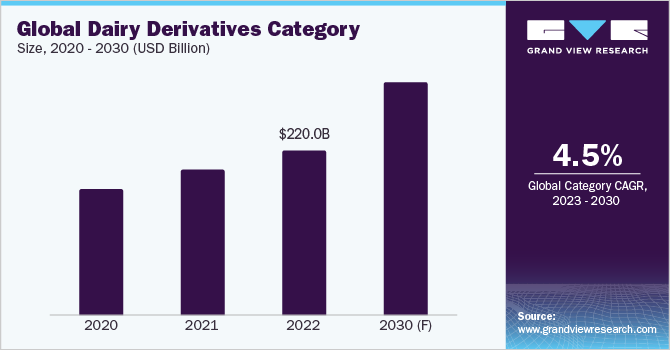
The global dairy derivatives category size was valued at USD 220 billion in 2022. The increasing use of dairy derivatives in pharmaceutical applications as they are used in a variety of products, such as dietary supplements and infant formula. The increasing demand for these products is driving the demand for this category. The increasing change in dietary preferences is where consumers are increasingly looking for healthier and more convenient food and beverage options. Dairy derivatives offer a number of health benefits, and they are also a convenient way to add protein and calcium to the diet.
Chromatography is a method for separating and distinguishing the various parts of a mixture. Different kinds of lipids, proteins, and carbs in milk are separated and identified using that method. By passing a liquid across a membrane, the ultrafiltration process can separate various components in a liquid. Proteins from milk are concentrated and whey is separated from milk using this method. To provide fresh and cutting-edge dairy products, the industry utilizes nanotechnology, utilizing materials, and technologies at the nano level. For instance, newer, more easily digestible milk proteins or improved methods of dairy product preservation can be developed using nanotechnology. Microfiltration is a technique used to separate different components in a liquid by passing it through a membrane with small pores. It is used to remove bacteria and other microorganisms from milk.
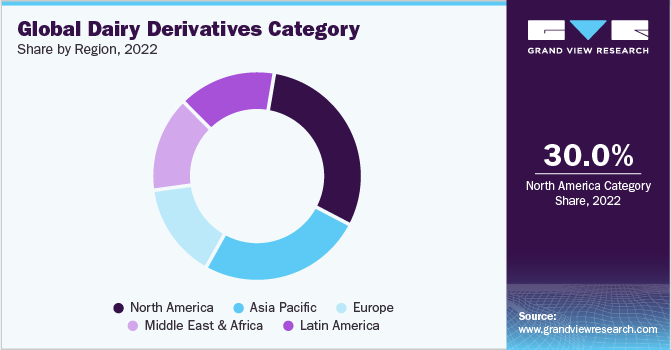
In North America, the United States is the world's largest producer of milk, and it is a major player in this sector. The U.S. dairy industry comprises a large number of small and medium-sized businesses, as well as a few large multinational corporations. In Europe, Germany is the largest producer and exporter of dairy products. In APAC, India is the world's largest producer of milk, and it is a major producer and consumer of dairy products. New Zealand is the world's largest exporter of dairy products, and it is a major player in the global dairy derivative category. The New Zealand dairy industry is known for its high-quality and sustainable practices. Brazil is the region's top milk producer and a significant producer and consumer of dairy goods. Brazil's dairy industry is expanding quickly, and in the upcoming years, it is anticipated that it will play a significant role in this sector.
Supplier Intelligence
“How can the nature of the global dairy derivatives category be best described? Who are the key players in this category?”
This category is highly fragmented and is dominated by a huge number of small and medium-sized businesses, and the top five competitors only hold a minor portion of the overall market share. This fragmentation is caused by a number of things, such as the low entry barriers, the variety of goods offered, and the various uses of dairy derivatives. The category offers low barriers to entry, allowing small and medium-sized companies to compete with larger players. It offers a diverse range of products, from simple lactose to complex whey protein concentrate, allowing for specialization and targeting specific market segments. Dairy derivatives are used in various industries, including food and beverage, pharmaceuticals, and cosmetics, providing opportunities for companies to target specific segments.
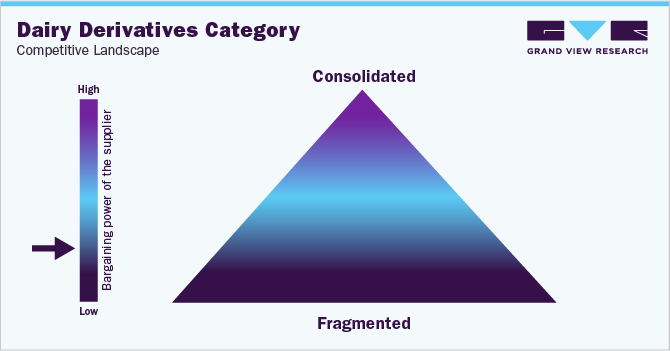
Key suppliers covered in the category:
-
Nestle
-
Danone
-
Amul
-
Fonterra
-
Dean Foods
-
Saputo
-
Mengniu Dairy
-
Yili Group
-
Tyson Foods
-
Arla Foods
Pricing and Cost Intelligence
“What are some of the key cost components or elements involved in the dairy derivatives category? Which factors influence the prices?
The cost of raw materials, such as milk, whey, and lactose, is a major cost component in the dairy derivatives market. The cost of these raw materials can vary depending on the market conditions, such as the supply and demand for milk. The average price in the U.S. is USD 4.31 per gallon for conventional whole milk in 2023. The cost of processing dairy derivatives, such as separating the whey from the milk and drying the whey, is another major cost component. The cost of processing can vary depending on the type of dairy derivative being produced and the scale of the operation. The cost of packaging dairy derivatives, such as bottles, cartons, and pouches, is another cost component. Aseptic packaging is a type of packaging that is designed to protect dairy products from contamination. It is often used for dairy products that are intended to be stored for long periods. It costs around USD 300 per thousand pieces. The cost of packaging can vary depending on the type of dairy derivative being produced and the type of packaging being used. The cost of distributing dairy derivatives to customers, such as transportation and storage, is another cost component. The cost of distribution can vary depending on the distance the dairy derivatives are being transported and the storage conditions required.
The following chart provides various costs incurred in this category and the major cost heads are shown below:
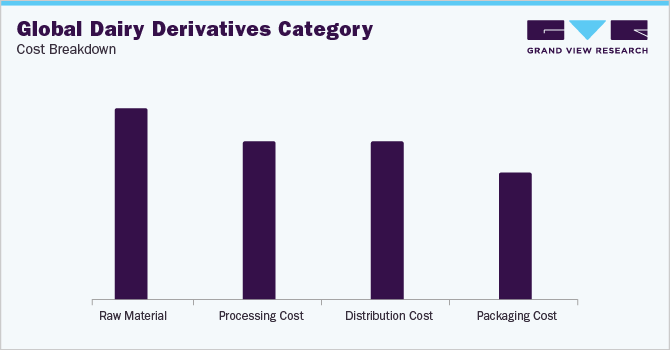
Businesses generally use a volume-based pricing model that determines the price of a product or service based on the volume of units purchased. It is widely used in the dairy derivatives category, enabling suppliers to offer discounts to buyers who purchase large quantities of products. This model offers several advantages, including increased sales, improved cash flow, and cost reduction by spreading production costs over a larger number of units.
The Dairy Derivatives Procurement Intelligence Report provides a detailed analysis of the cost structure and the pricing models adopted by prominent suppliers in this category.
Sourcing Intelligence
“Which countries are the leading sourcing destinations for the dairy derivatives category?
The U.S. dairy industry is the global leader in the dairy derivative category due to its large and growing market, strong focus on innovation, competitiveness, and quality. The industry's focus on innovation allows it to develop new dairy derivatives that meet consumer needs, while competitiveness drives down costs and improves efficiency. This category is expected to grow due to increasing demand for dairy products, and advancements in technology, which enable more efficient and cost-effective production of dairy derivatives. The industry's commitment to quality and innovation contributes to its position as a global leader in this category.
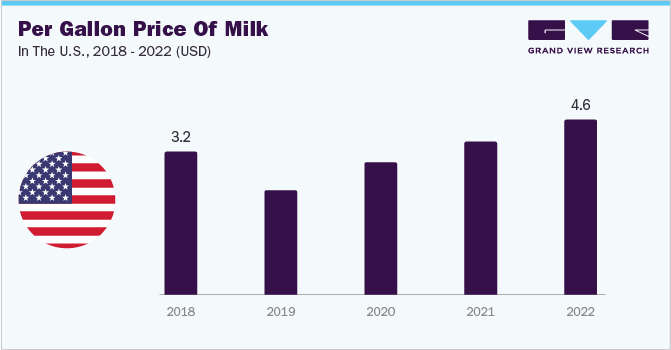
New Zealand is another major country in this category. The country's climate and abundant pastureland provide ideal conditions for dairy farming, resulting in high-quality milk with low in fat and high in protein. The country's strong dairy industry, consisting of small, global-reaching companies, is well-organized and efficient. The government provides support through programs such as research and development, export promotion, and market access assistance. New Zealand's animal welfare standards ensure cows are treated humanely and have access to good quality feed and water. Additionally, the country's dairy technology sector is constantly developing new and innovative ways to produce dairy products, improving the quality and efficiency of dairy production. Overall, New Zealand's unique combination of climate, pastureland, animal welfare, and dairy technology make it a strong contender in the global dairy derivative category.
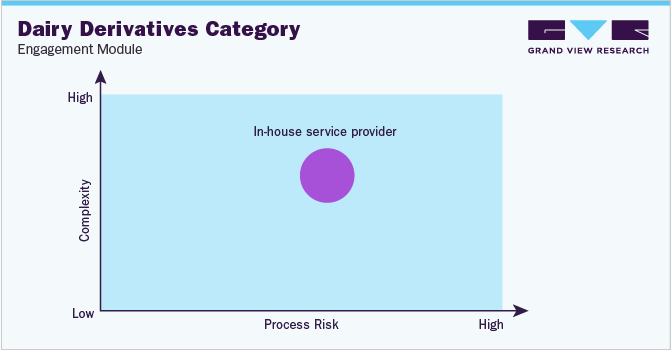
In terms of dairy derivative category sourcing intelligence, most suppliers opt for in-house service providers as it offers companies cost savings, control over customer service quality, and faster response times. The benefits of using an in-house service engagement model include better customer insights, increased customer loyalty, and improved brand reputation. This model can be beneficial for companies seeking cost savings and control over customer service quality. However, companies must carefully consider the advantages and disadvantages before deciding if it is the right fit for their needs. Companies with a dedicated customer service team can gain valuable insights into customer needs and preferences, enabling them to improve products and services. Additionally, good customer service can lead to increased sales and profits, and it reduces costs by eliminating the need for third-party companies to handle customer service needs. Customer service teams are trained to understand products and services, ensuring high service levels and efficient handling of inquiries, resulting in quicker resolution.
The dairy derivatives procurement intelligence report also provides details regarding day one, quick wins, portfolio analysis, key negotiation strategies of key suppliers, and low-cost/best-cost sourcing analysis.
Dairy Derivatives Procurement Intelligence Report Scope
Report Attribute
Details
Dairy Derivatives Category Growth Rate
CAGR of 4.5% from 2023 to 2030
Base Year for Estimation
2022
Pricing Growth Outlook
3% - 5%(Annual)
Pricing Models
Volume-based pricing model and cost-plus pricing model
Supplier Selection Scope
Cost and pricing, past engagements, productivity, geographical presence
Supplier Selection Criteria
Sustainability, price, quality, reliability, flexibility, technical specifications, operational capabilities, regulatory standards and mandates, category innovations, and others.
Report Coverage
Revenue forecast, supplier ranking, supplier positioning matrix, emerging technology, pricing models, cost structure, competitive landscape, growth factors, trends, engagement, and operating model
Key Companies Profiled
Nestle, Danone, Amul, Fonterra, Dean Foods, Saputo, Mengniu Dairy, Yili Group, Tyson Foods, and Arla Foods
Regional Scope
Global
Historical Data
2020 - 2021
Revenue Forecast in 2030
USD 312.86 billion
Quantitative Units
Revenue in USD billion and CAGR from 2023 to 2030
Customization Scope
Up to 48 hours of customization free with every report.
Pricing and Purchase Options
Avail customized purchase options to meet your exact research needs. Explore purchase options
Frequently Asked Questions About This Report
b. The global dairy derivative category size was valued at approximately USD 220 billion in 2022 and is estimated to witness a CAGR of 4.5% from 2023 to 2030.
b. Increasing demand for dairy products due to population growth and changing dietary preferences for healthier and more convenient food options are driving the growth of the category.
b. According to the LCC/BCC sourcing analysis, the US and New Zealand are the ideal destinations for sourcing dairy derivative category.
b. This category is highly fragmented with the presence of many mid-sized players competing for the market share. Some of the key players are Nestle, Danone, Amul, Fonterra, Dean Foods, Saputo, Mengniu Dairy, Yili Group, Tyson Foods, and Arla Foods
b. Raw material, processing cost, packaging cost and distribution cost are the major key components of this category.
b. Establish a long-term relationship, consider the quality of the dairy derivatives and delivery terms are some of the best sourcing practices in this category.
Share this report with your colleague or friend.
GET A FREE SAMPLE
This FREE sample includes market data points, ranging from trend analyses to market estimates & forecasts. See for yourself...
Add-on Services
Should Cost Analysis
Component wise cost break down for better negotiation for the client, highlights the key cost drivers in the market with future price fluctuation for different materials (e.g.: steel, aluminum, etc.) used in the production process
Rate Benchmarking
Offering cost transparency for different products / services procured by the client. A typical report involves 2-3 case scenarios helping clients to select the best suited engagement with the supplier
Salary Benchmarking
Determining and forecasting salaries for specific skill set labor to make decision on outsourcing vs in-house.
Supplier Newsletter
A typical newsletter study by capturing latest information for specific suppliers related to: M&As, technological innovations, expansion, litigations, bankruptcy etc.
![gvr icn]()
NEED A CUSTOM REPORT?
We can customize every report - free of charge - including purchasing stand-alone sections or country-level reports, as well as offer affordable discounts for start-ups & universities.
Contact us now to get our best pricing.
![esomar icon]()
ESOMAR certified & member
![ISO]()
ISO Certified
We are GDPR and CCPA compliant! Your transaction & personal information is safe and secure. For more details, please read our privacy policy.
We are committed towards customer satisfaction, and quality service.
Client Testimonials

"The quality of research they have done for us has been excellent..."
ISO Certified


